Magnetic shielding for a pet detector system
a detector system and magnetic shielding technology, applied in the field of medical imaging arts, can solve the problems of long lag time, minimal patient disturbance, and availability of both ct and spectroscopic imaging capabilities, and achieve the effect of improving workflow efficiency and efficient and effective retrofitting
- Summary
- Abstract
- Description
- Claims
- Application Information
AI Technical Summary
Benefits of technology
Problems solved by technology
Method used
Image
Examples
Embodiment Construction
[0035]With reference to FIGS. 1-5, a hybrid imaging system includes a magnetic resonance scanner 10, a second modality imaging system 12, and a patient support, such as an illustrated patient bed 14, disposed between the magnetic resonance scanner 10, a second modality imaging system 12. A radio frequency shield substantially surrounds and defines a radio frequency isolated room or space 16. The magnetic resonance scanner 10, the second modality imaging system 12, and patient bed 14 are disposed within the radio frequency isolated room. The magnetic resonance scanner 10 in some embodiments is a commercial magnetic resonance scanner such as an Achieva or Intera magnetic resonance scanner available from Philips Medical Systems, Eindhoven, The Netherlands. More generally, the magnetic resonance scanner 10 can be substantially any type of scanner, such as the depicted horizontal cylindrical bore magnet scanner, an open bore scanner such as the Panorama magnetic resonance scanner availab...
PUM
 Login to View More
Login to View More Abstract
Description
Claims
Application Information
 Login to View More
Login to View More - R&D
- Intellectual Property
- Life Sciences
- Materials
- Tech Scout
- Unparalleled Data Quality
- Higher Quality Content
- 60% Fewer Hallucinations
Browse by: Latest US Patents, China's latest patents, Technical Efficacy Thesaurus, Application Domain, Technology Topic, Popular Technical Reports.
© 2025 PatSnap. All rights reserved.Legal|Privacy policy|Modern Slavery Act Transparency Statement|Sitemap|About US| Contact US: help@patsnap.com



